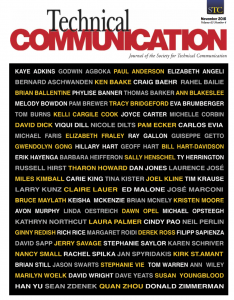By Sam Dragga | Technical Communication Editor
I have several news items to share about STC’s quarterly research journal:
Changes to Cover Competition: Two Annual Deadlines
The competition to create the illustration for the journal’s cover is getting simpler with only two deadlines a year and two topics for covers announced at the same time. This change will give potential contributors a choice of projects during each competition period and allow more time to create the illustrations.
Following are the calls for covers for the February and May 2017 issues. For this initial pairing of issue covers, the call allows only a three-month window for creation of the illustrations. The deadline for submission is December 1.
Thereafter, the calls for covers will be issued
- December 1 for the August and November issues, with a June 1 deadline
- June 1 for the February and May issues, with a December 1 deadline
Cover Competition: February 2017 and May 2017 issues
The February 2017 issue of Technical Communication is a special issue on the subject of “Globalizing User Experience: Strategies, Practices, and Techniques for Culturally Sensitive Design.”
We are inviting illustrations that reinforce the subject of this special issue of the journal to be guest edited by Guiseppe Getto and Huatong Sun.
In creating your illustration for the February issue, you might consider
- UX in cross-cultural and international product deployment
- culturally sensitive design and UX research methods
- the impact of UX on the digital divide
- UX practices that cultivate diversity in organizations and societies
- UX and globally distributed teams
- influences on the design of information products for local cultures
- cultural differences regarding intellectual property and their impact on technical communication practices
The May 2017 issue of Technical Communication is a regular issue with articles on multiple topics. For this regular issue we are inviting cover illustrations on the subject of minimalist writing techniques.
In creating your illustration for the May issue, you might consider
- minimalist writing and the self-directed/self-correcting user
- the contribution of minimalist writing to user fulfillment
- costs and benefits of minimalist writing
- right and wrong times for minimalist writing
- minimalist writing versus plain or simplified language
- the evolution of minimalist writing
- variations of minimalist writing
For either issue, please submit your illustration (approximately 20×20 cm or 8×8 inches) as a high-resolution (300 dpi) jpg file by 1 December 2016 to tceditor@stc.org with a brief explanation (100-200 words) of how your illustration addresses the designated cover subject. Submissions will be anonymously reviewed, and a jury of peers will select each issue’s cover. Honorable mentions will be published inside the journal.
For examples of previous covers, please visit the journal’s website at https://www.stc.org/techcomm.
Special Issue in November
The November 2016 issue of the journal will focus on the subject of “Communication of Research Between Academic and Practicing Professionals” and will be guest edited by Mike Albers of East Carolina University. This special issue will include five articles that are sure to generate lively conversation in the coming year.
“Toward Multidirectional Knowledge Flows: Lessons from Research and Publication Practices of Technical Communication Entrepreneurs, by Benjamin Lauren and Stacey Pigg, summarizes interviews with eight practitioners to examine the influence of networking activities on learning and practice. Be sure to read this article if you are looking for answers to the following questions: Which publications are practitioners reading? Is the academic-practitioner binary informative or inadequate? How might practitioners and academics more effectively exchange research information?
“Patterns of Dissemination: Examining and Documenting Practitioner Knowledge Sharing Practices on Blogs,” by Mark Hannah and Chris Lam, offers a statistical analysis of blogs written by practitioners. Questions answered in this article are several: Which topics occur with the highest frequency in the blog postings: technology, professionalization, or communication strategies? How frequent or infrequent are postings about research studies? How might academics cooperate or collaborate with practitioners on research issues?
 “Academics Are from Mars, Practitioners Are from Venus: Analyzing Content Alignment within Technical Communication Forums,” by Ryan Boettger and Erin Friess, analyzes published articles across a 20-year period according to topic and audience. Issues addressed include the following: How have publications changed in this period of time? Are academics and practitioners reading the same articles? How cohesive or divided is attention of the discipline?
“Academics Are from Mars, Practitioners Are from Venus: Analyzing Content Alignment within Technical Communication Forums,” by Ryan Boettger and Erin Friess, analyzes published articles across a 20-year period according to topic and audience. Issues addressed include the following: How have publications changed in this period of time? Are academics and practitioners reading the same articles? How cohesive or divided is attention of the discipline?
“Reflections on Research: Examining Practitioner Perspectives on the State of Research in Technical Communication,” by Kirk St.Amant and Lisa Meloncon, reports on thirty interviews with practitioners to answer vital questions about the field: Which topics of research do practitioners consider especially important? Are practitioners willing to participate in collaborative projects with academics? How might practitioners and academics cultivate shared perspectives on research?
“Technical Communication, Academic Research, And Patient Education: A Multidisciplinary Collaboration” by Corinne Renguette, is a case study of practitioner-academic collaboration, specifically regarding the application of user-center design principles to the creation of a software application. Here you will find answers to key questions about the collaborative process: How was this collaboration initiated? How did it proceed? What was its level of success and how was this determined? Was the collaboration equally productive for the academic and practitioner sides?
The issue will also include 24 book reviews as well as summaries of 36 articles from related journals in the field—unique attributes that make Technical Communication a vital information resource for practitioners and academics in the field.
Comments and Questions
As always, if you have questions about the journal (or praise or criticism), I would appreciate getting your message at tceditor@stc.org.


